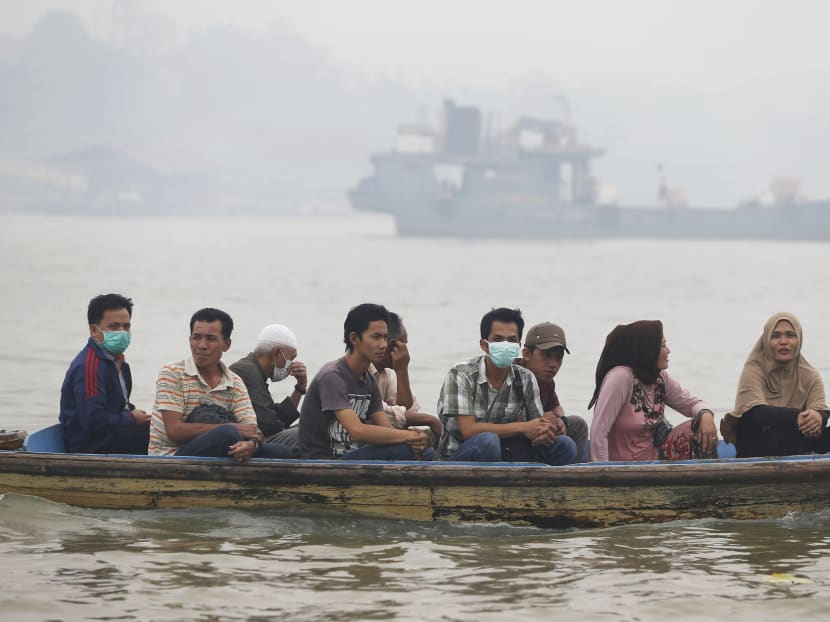S’pore renews offers to help Indonesia fight fires
SINGAPORE — With the haze situation worsening — and culprits potentially in breach of the Transboundary Haze Pollution Act — Singapore has renewed offers to help in firefighting operations, while pressing their Indonesian counterparts for more information on the cause of the fires.

People sit on a wooden boat as they cross the haze shrouded Batanghari River in Jambi, Indonesia Sumatra island, Sept 14, 2015. Photo: Reuters
SINGAPORE — With the haze situation worsening — and culprits potentially in breach of the Transboundary Haze Pollution Act — Singapore has renewed offers to help in firefighting operations, while pressing their Indonesian counterparts for more information on the cause of the fires.
Cautioning that air quality could creep into “very unhealthy” territory tomorrow (Sept 15), the National Environment Agency said Minister for the Environment and Water Resources Dr Vivian Balakrishnan spoke with his Indonesian counterpart Dr Siti Nurbaya Bakar this afternoon, expressing his concern over the serious haze situation and reiterating Singapore’s offer of help to Indonesia.
In its advisory today, the NEA forecasted that the 24-hour Pollutant Standards Index (PSI) to be in the mid to high end of the unhealthy territory (101 to 200), and could edge into the low end of the very unhealthy range (201 to 300).
As at 11pm, the 24-hour PSI reading ranged from 128 to 160. The three-hour PSI reading was even higher — at 181. The one-hour PM2.5 reading — tiny particles in the air that are two-and-one-half microns — was 142 to 238 mcg/m3.
The NEA said Dr Siti Nurbaya, who is Indonesia’s Minister of Environment and Forestry, has agreed to provide Singapore a list of companies suspected to be behind the land and forest fires once the information has been confirmed.
On Singapore’s offer of help, the NEA said Dr Siti Nurbaya explained that the Indonesian authorities had already deployed a host of resources, but will consult Indonesian President Joko Widodo — who is personally overseeing Indonesia’s effort —again on Singapore’s offer.
Last year, Singapore passed the Transboundary Haze Pollution Act, which states that haze pollution has occurred if the 24-hour PSI — for the same or any part of Singapore — remains above 100 for at least 24 hours. It further stipulates that it is an offence for any entity to cause or contribute to haze pollution here.
Over the past week, this has occurred at least twice. The 24-hour PSI lingered in the unhealthy range for 41 hours from 10am last Thursday till early Saturday morning. It re-entered unhealthy territory at 8pm on Saturday, and has remained in or above it since.
The NEA said it has been monitoring the situation closely and is investigating. More information will be shared when it is in a position to do so.
Under the Act, local or foreign firms can be fined up to S$100,000 a day for causing or contributing to haze, capped at S$2 million.
Experts felt that the reach of the legislation and the authorities’ investigative powers were hampered by the lack of maps showing plantation concessions — which could help identify culprits.
National University of Singapore (NUS) law professor Alan Tan said identifying the culprits to enforce the Act will not be easy, as the Indonesian government has not shared the plantation concession maps. Even if these are shared, they are likely to be unreliable. “The problem on the ground is that boundaries are uncertain and there are often local communities who encroach into the plantations’ lands to start fires there … In such situations, it is difficult to tell who is responsible,” he said.
Due to the presence of cloud cover and nearby fires, satellite images could be inaccurate. Identifying culprits would require ground evidence and time is needed to compile this, he added. Suggesting any investigation would likely begin with a Singapore-linked company, he said: “Whether this will deter other perpetrators is hard to say … It is the enforcement of domestic laws by the Indonesia authorities that will make a real difference,” he said.
Dr Santos Salinas, a senior research scientist at the NUS Centre for Remote Imaging, Sensing and Processing, felt that the maximum fine of S$2 million was “small change” to larger firms. “A better deterrent would be the withdrawal of their concession rights for a number of years,” he said.
Dr Erik Velasco, a research scientist at the Singapore-MIT Alliance for Research and Technology’s Centre for Environmental Sensing and Modelling, felt the recent haze episode proves that a unilateral law enacted by the Government “has not worked”. Instead, tabling a law among Association of South-east Asian Nations member countries to hold firms accountable would “get some success”, he added.
However, Singapore Institute of International Affairs chairman Simon Tay pointed out that certain clauses in the Act were “quite powerful”, granting the authorities the rights to request firms to deploy fire-fighting personnel, and to obtain relevant information from firms.






